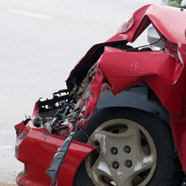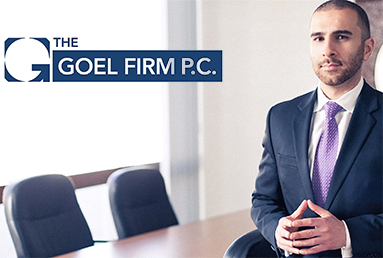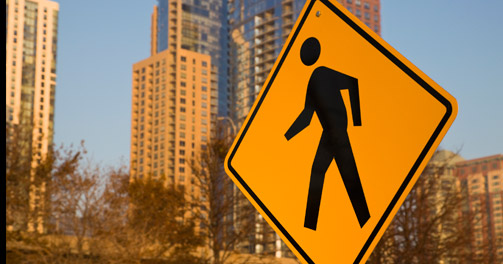
PEDESTRIAN ACCIDENTS
According to the National Highway Traffic Safety Administration, 4,280 pedestrians were killed and an estimated 70,000 were injured in traffic crashes in the United States in 2010. This means a pedestrian was killed every two hours and injured every eight minutes in traffic incidents. Even though there has been a decrease in pedestrian fatalities in the past ten years, such fatalities and injuries remain a serious concern in road safety.
Although actions are typically against the driver of a vehicle, a collision of a vehicle with a pedestrian using a roadway may support claims against parties other than the driver or owner of the vehicle. For example, the circumstances of the accident may support a negligence action against the governmental entity responsible for road conditions at the site of the collision. In some cases for instance, a city has been held to have a duty to ensure that a crosswalk would be reasonably safe for its intended use in light of circumstances present at crosswalk.
There may also be circumstances where the pedestrian was in the roadway involuntarily, which makes it possible to bring a suit against the parties responsible for the injured party’s presence in the roadway. For example, a pedestrian is pushed or forced into the roadway by another or a child was forced into a street because of a dog attack. In these types of situations, a suit can be initiated against the parties or owners responsible for the forced entry onto the roadway.
In cases where the pedestrian is a child or other person of limited capacity, an action may lie against the person or persons responsible for supervising the pedestrian. This could be a school, youth group, day care and others who would be responsible for supervising a child. As evident by these examples, pedestrian accidents can vary significantly, which makes it all the more important to contact a personal injury attorney immediately after such an incident.
Actions Against an Operator of a Motor Vehicle:
In actions against a driver of a motor vehicle, the law typically requires that the operator owe to pedestrians walking along the highway or street the duty to exercise reasonable or ordinary care to avoid injuring them. Whereas, the law requires that pedestrians must exercise reasonable care for their own safety in such cases. Specifically, the operator of a motor vehicle must anticipate the presence of pedestrians walking alongside the highway or street, while pedestrians must expect to find, and must watch for, the approach of vehicles in the middle of the road.
To establish a prima facie case in an action to recover for personal injury or wrongful death of a pedestrian struck by a motorist on a roadway, the plaintiff must prove that:
(1) The defendant had a duty to exercise reasonable care in the operation of his or her vehicle;
(2) The defendant failed to exercise reasonable care;
(3) The defendant’s breach of duty proximately caused the plaintiff’s injury or the death of the plaintiff’s decedent.
However in certain circumstances, a motorist may owe a higher degree of care to certain pedestrians. For instance, a motorist must exercise a higher degree of care when there is a possibility of children on or near the roadway. Motorists may also owe a greater degree of care to persons working on the roadway.
RECOVERABLE DAMAGES:
In an action to recover for injury to a pedestrian struck by a motor vehicle, a victim’s damages may typically include hospital and medical expenses, pain and suffering, lost earnings, and impaired earning capacity. However, a victim may be able to recover punitive damages if the defendant’s conduct constituted more than mere negligence. This means the victim will have to demonstrate the driver’s willfulness, wantonness, gross negligence, or reckless or conscious disregard for the safety of pedestrians.
● Medical Expenses
Moderate and serious injuries sustained in a pedestrian accident can lead to significant medical bills. For example, hospitalization at a trauma center for a head injury can cost as much $100,000. An attorney dedicated to personal injury claims will help you recover the costs for any hospital stay, surgery, doctors’ visits, diagnostic tests, physical and rehabilitative therapy, and chiropractic care. You may further be entitled to the costs of future medical care, if your injuries require ongoing treatment.
● Pain and Suffering
A pedestrian accident may inflict a wide range of injuries, whether they are temporary, longer-term, or permanently disabling. The law allows for compensation for the pain and suffering associated with such accident injuries, yet it does not provide a fixed formula to calculate that type of compensation. To recover the maximum amount that your injuries warrant, one will need the help of a dedicated personal injury attorney who is equipped with the knowledge, resources and experience to best evaluate your claim.
● Loss of Wages
Time lost at work due to injuries inflicted by such an accident can be significant and have serious ramifications on your finances and family responsibilities. If your accident injuries prevent you from working, then all your lost wages may be included in any claim for recovery against the negligent party and the liable carrier. Even if you used sick leave or vacation time during the recovery period, reimbursement may be available in your recovery. What if your injuries leave you permanently disabled and unable to work ever again? In conjunction with this firm’s experts, a personal injury lawyer can calculate your future losses and recover for your diminution in lifetime earning capacity.
● Loss of Consortium
Loss of consortium is a cause of action that may be brought by a spouse of the injured party for loss or harm he or she suffered as a result of bodily injury caused to the injured spouse by the negligent party.
● Wrongful Death
If a pedestrian accident resulted in the death of a party, then there may be a cause of action for wrongful death. A wrongful death action arises in favor of certain statutory outlined survivors of a decedent of an accident. The survivors who are entitled to bring a wrongful death claim include but are not limited to the decedent’s surviving spouse, domestic partner, children, or issue of deceased children.
IMPORTANT STEPS TO TAKE AFTER A PEDESTRIAN ACCIDENT:
following are very important steps you should take in the immediate aftermath of such an accident:
(1) Call the police and file an accident report. Filing such a report will help document the event and provide important details regarding the accident.
(2) Receive prompt medical attention for yourself or anyone involved in the accident. Usually injuries from a pedestrian accident require emergency care, so immediately call an ambulance for transport to a hospital. If the injuries are not serious, visit an urgent care medical center or arrange to be seen by your regular physician. Some pedestrian accident injuries, including serious ones, may be latent and hence it is essential to be examined by a medical care provider as soon as possible.
(3) If possible, attempt to gather information at the scene of the accident. Try to take photos of the accident scene, property damage, and if there are witnesses to the accident, obtain their names and contact information. Witnesses to such accidents can be crucial in determining who was at fault.
(4) Do not give statements to the insurance companies’ representatives about the accident without first contacting an attorney.
-
Client Testimonials
See What Our Clients Have
To Say -
The Goel Firm Blog
Personal Injury & Insurance
News and Discussion. -
Free case evaluation.
Let Us Review
Your Case
The Goel Firm P.C.
9440 S. Santa Monica Boulevard Suite 301
Beverly Hills, California 90210
T: 424 281 4377
F: 888 800 4598
info@goelfirm.com









